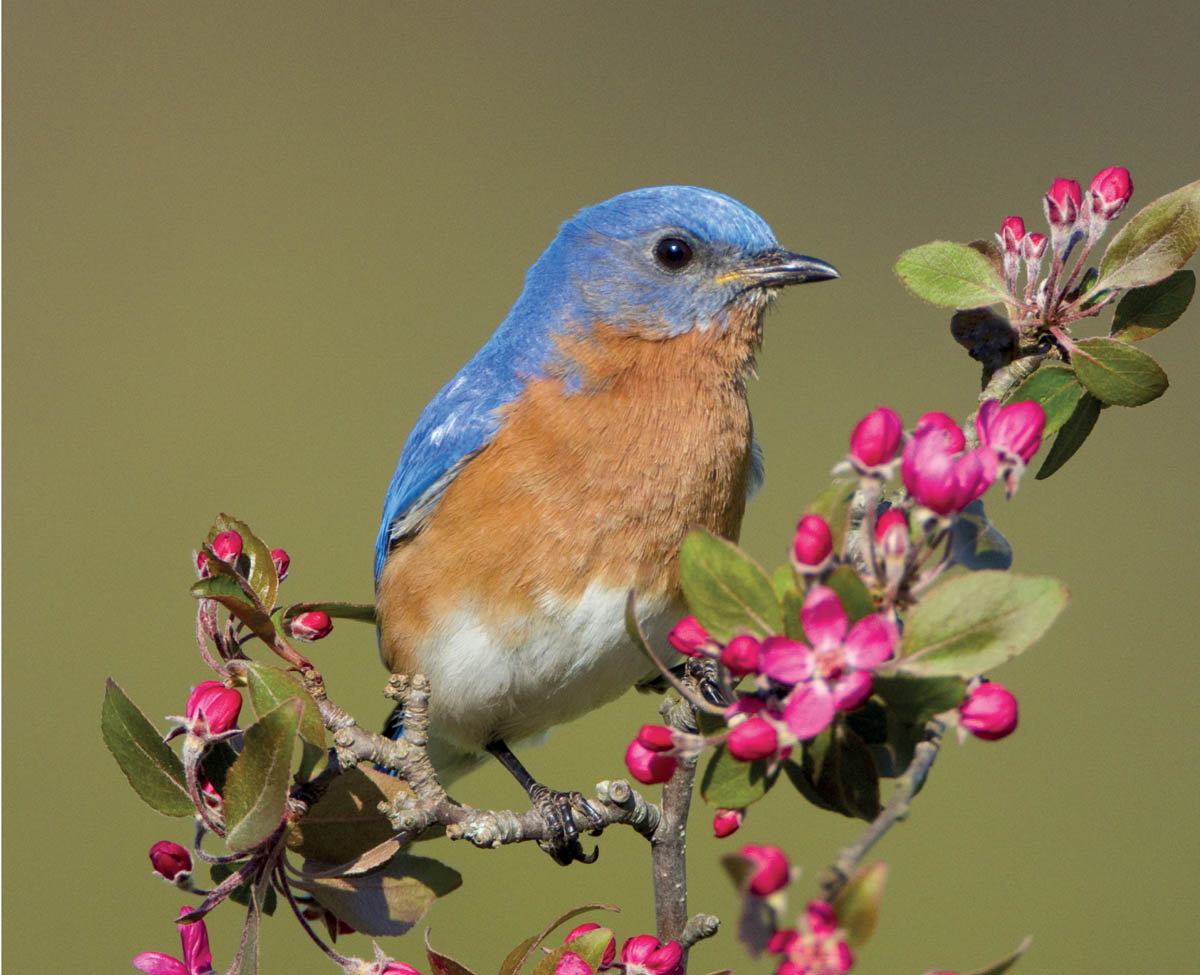
Eastern Bluebird male
It’s easy to understand why we humans associate bluebirds with happiness, because how can we not feel happy seeing them and hearing their soft, lovely song on beautiful spring mornings? Other birds may have equally pleasing songs, but few sing from as conspicuous perches as bluebirds do. And the easily observed habits of Eastern, Western, and Mountain Bluebirds stir our hearts in ways that more secretive birds simply cannot.

Eastern Bluebird male
The legendary “bluebird of happiness” notwithstanding, bluebirds are surely no happier or sadder than other birds. In fact, bluebird life can be fraught with bickering, physical attacks, and matings outside of the pair bond. Males fight other males, females fight other females, males and females fight one another, and they all fight with Tree Swallows. From one-quarter to three-quarters of all bluebird broods can have at least one chick sired by a male other than the one raising them. Despite all that drama, most bluebirds stick with their social mate, often remaining together even through winter and never asking for paternity tests.
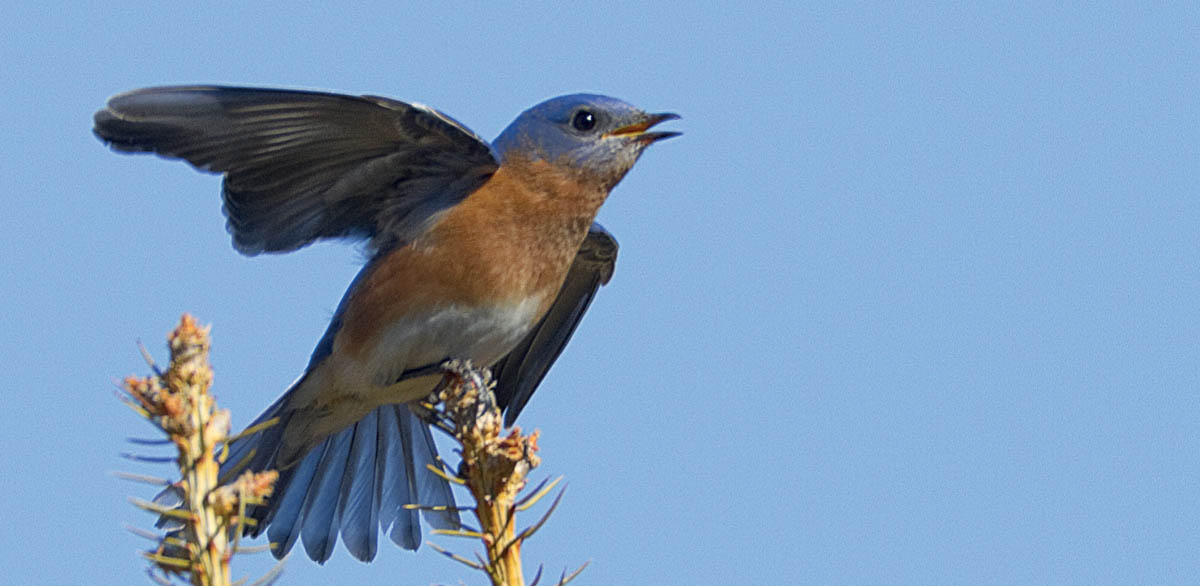
A male Eastern Bluebird sings as he alights on top of a conifer. His song is a fairly low-pitched series of one- to three-note warbled phrases. Unpaired males sing from a high perch or sometimes in flight as they try to attract a mate.
Eastern Bluebird pairs get established after a male selects a nest box or cavity and then performs a nest demonstration display. When a female is near, he brandishes some nesting material at the entrance hole, carries it in and out again, and then perches atop the nest site and waves his wings. If she enters the nest cavity, that seals the deal.
Then it becomes her responsibility to build the nest, constructing it from grasses and pine needles and lining it with finer grasses and sometimes feathers or horsehair. Once paired the male and female patrol their territory boundaries, both sexes aggressively keeping out intruding bluebirds, especially near potential nesting sites.
The female begins laying eggs after the nest is complete, from the very next morning to as much as three weeks later. She lays one egg early each morning until she’s produced a clutch of two to seven eggs, most often five eggs in spring or four later in summer. When the clutch is complete, she starts incubating. Many males, especially in migratory populations, feed their mate during nest-building and incubation.
She incubates all night and then takes a fairly long break first thing in the morning to eat and stretch after her long fast. She takes occasional, shorter breaks during the day. Incubation lasts an average of 14 days, longer in colder weather and shorter in hot weather.

Atop a nest box, a male Eastern Bluebird performs a wing-waving display when a female is near. He flies to the cavity entrance, sometimes holding a piece of nesting material, then repeatedly puts his head into the cavity and rocks back and forth, going in and out of the hole several times and waving one or both wings as the female approaches. He may go through this ritual at several different cavities before the female accepts one.
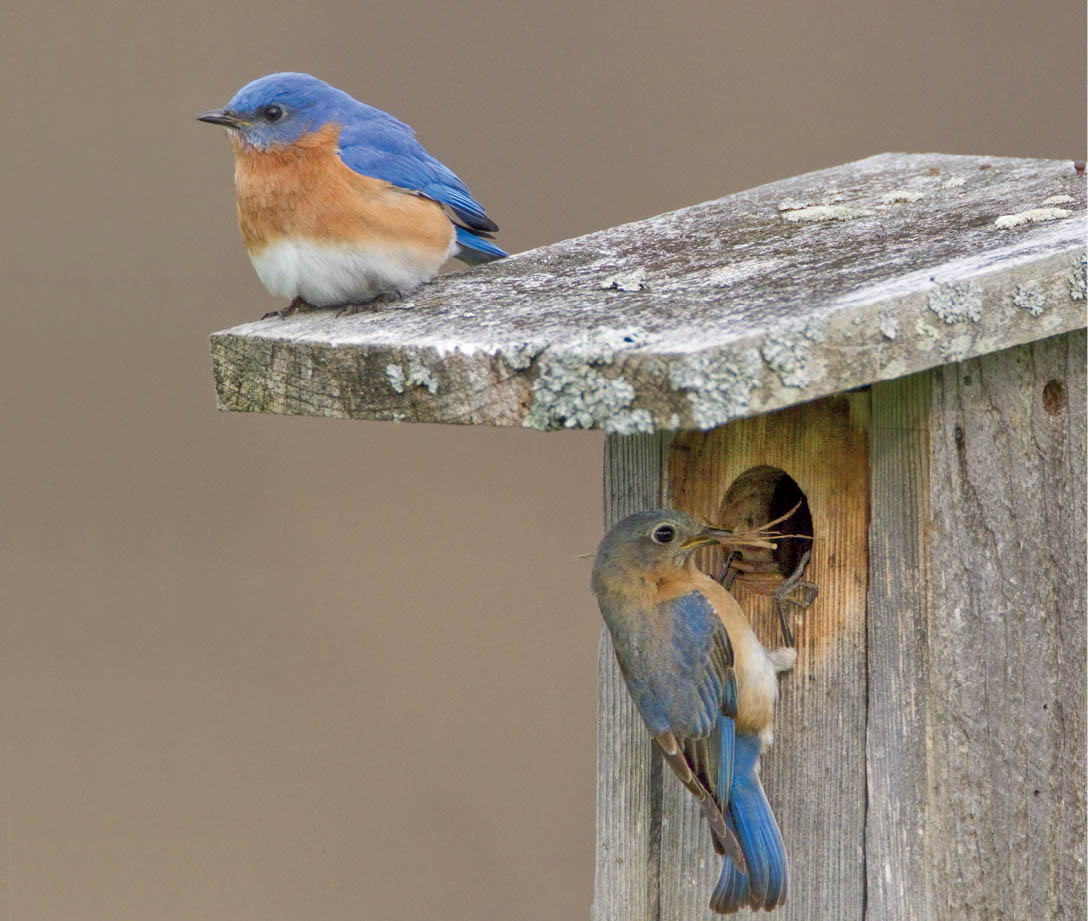
A female Eastern Bluebird brings a beakful of pine needles to her nestbox. The male may bring nest material, too, but the female builds the nest alone. She forms a cup inside the cavity using coarse grasses and pine needles, shaping it with her body, then adding a lining of finer materials. Bluebirds may use the same nest more than once.
The entire clutch usually hatches within 24 hours. During the heat of summer, some of the first eggs laid may start developing before incubation even begins and may hatch days before the last eggs do.
Both parents feed the young and carry off fecal sacs. They split duties fairly evenly except in cold weather, when the mother broods the tiny nestlings more; then the father must spend more time searching for food and feeding them.
The nestlings seem to get along well with no squabbling at all. They remain in the cavity for 17 to 21 days and are usually fairly strong fliers from their first flight. If frightened out of the nest prematurely, they will not be able to return easily, though some birds have managed to climb into the nest again. The fledgling siblings huddle together for warmth, and crouch, freeze in position, or fly away when frightened. They also bathe, preen, and learn how to catch their own food.
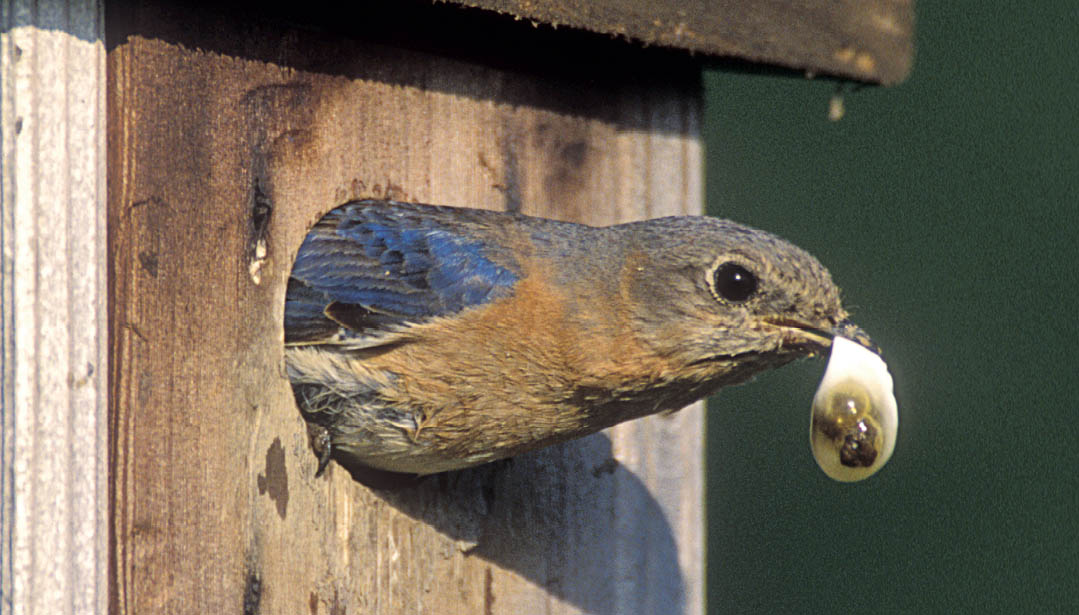
An Eastern Bluebird female carries a fecal sac out of her nest box. Like other birds, bluebird nestlings often defecate after being fed. The adult grasps the fecal sac as it is produced and flies out of the nest entrance, dropping the sac a distance away.
Eggs. This Eastern Bluebird nest contains the typical four eggs, but clutch size may vary from two to seven eggs, usually pale or sky blue in color, but occasionally white. Bluebirds may produce as many as three broods per season.

1–2 days old. An Eastern Bluebird nest with four nestlings. Altricial, they hatch naked except for sparse, grayish down, and with eyes closed. Dark feather tracts are developing on their crowns and along their backs. Their wing feathers will start to break through the skin in another day.

8 days old. Four nestlings beg, showing bright yellow gapes edged with white, their mouths becoming redder closer to the throat. Their eyes have opened and their feathers, especially on their wings, are growing rapidly, although their heads are still downy. They now can maintain their own body temperature, and so are seldom brooded during daytime.
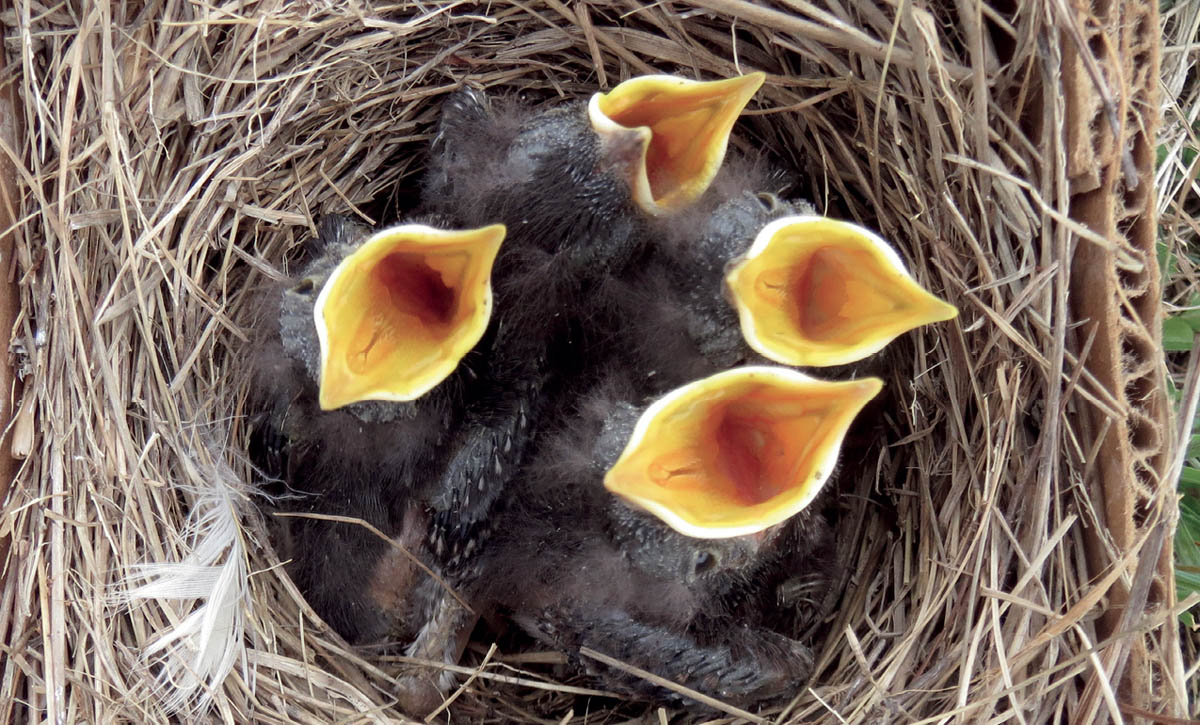
Week 2. Inside the nest, four bluebird nestlings beg from their mother. The pinfeathers on their wings show they are in their second week of life. The young are fed more in early morning than later in the day.

Bluebird young stay in the nest for 17 to 21 days, significantly longer than many open-cup nesters because, without a safety net of leafy branches beneath the nest, these hole-nesting birds must fly well when they fledge. As fledglings leave the nest, they flutter to the nearest perch, hopefully a spot with some safe cover. Given their open habitat, this may be as far as 150 feet from the nest. They stay near cover for seven to ten days, becoming bolder and stronger, finally able to fly with their parents over longer distances. A week or two after leaving the nest, bluebirds start dropping from perches to catch insects on the ground. They’re about half as effective as their parents at first, but they’re quick learners. Within another week or two, they’ll be finding their own food and become independent.
Fledglings from early broods usually leave their parents’ territory once they can fend for themselves, particularly when the adults have started the next brood, at which point they may act aggressively toward the young birds.
At this point, juveniles from first broods of the season start associating with other juveniles, wandering away from their family territories, and forming flocks. Young from the last brood of the season often remain with their parents longer, sometimes through the winter.
In spring, the process of nesting starts all over. Pairs from the previous year are often likely to remain together, especially if they were successful rearing young together.
Mountain and Western Bluebirds are fairly similar to Eastern Bluebirds in their nesting habits. All three bluebirds are social, joining large flocks in late summer and wandering together throughout winter. And all three nest in cavities. In some cases, Western Bluebird pairs have help raising young, by offspring from previous years or earlier nests that year, or by unattached adults, especially males. This cooperative nesting is exceptionally rare in Eastern and Mountain Bluebirds.
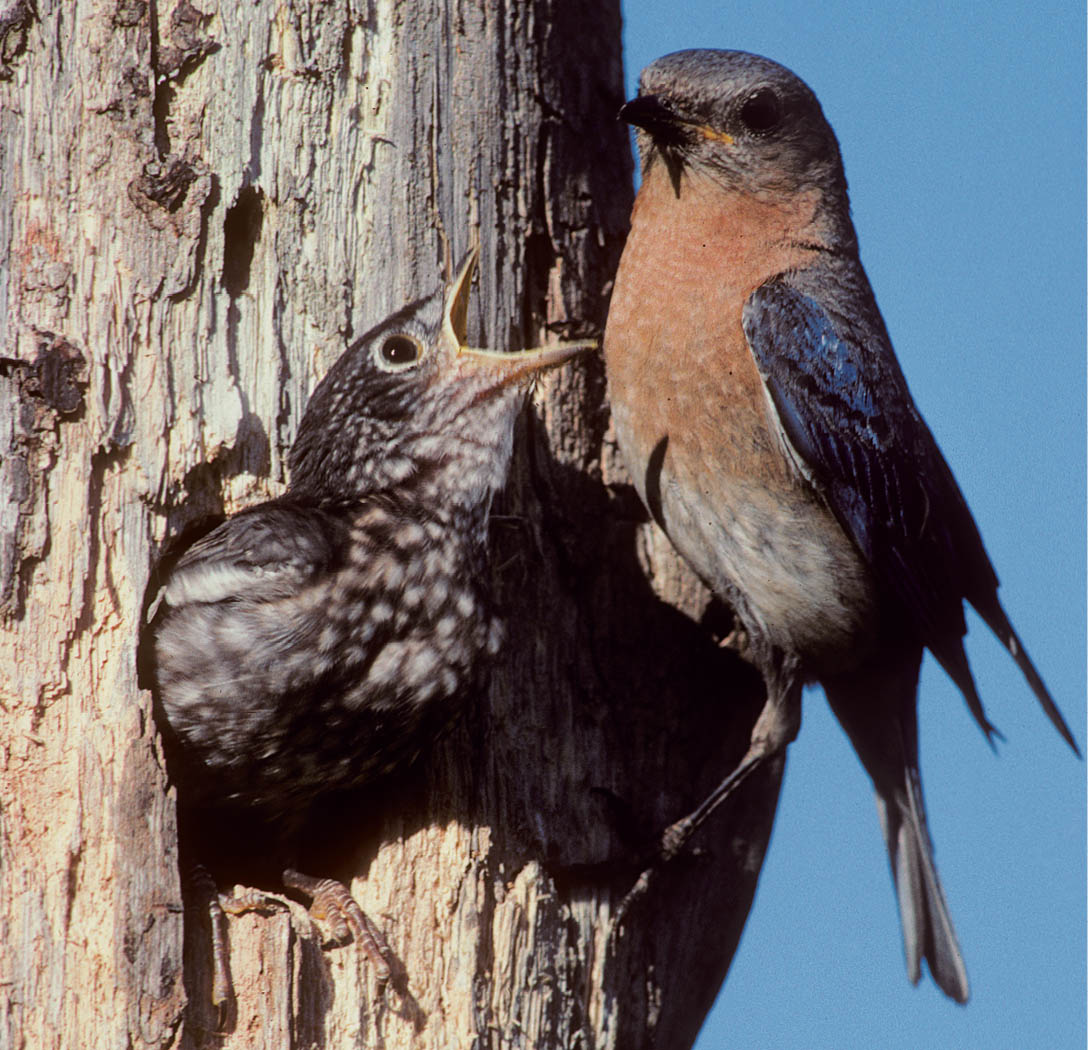
An Eastern Bluebird nestling pleads with its mother to feed it, but she arrived without food. Just before fledging, parents may feed chicks less often, or bring food but not let the young take it, to coax the young birds to make that first leap into the world.
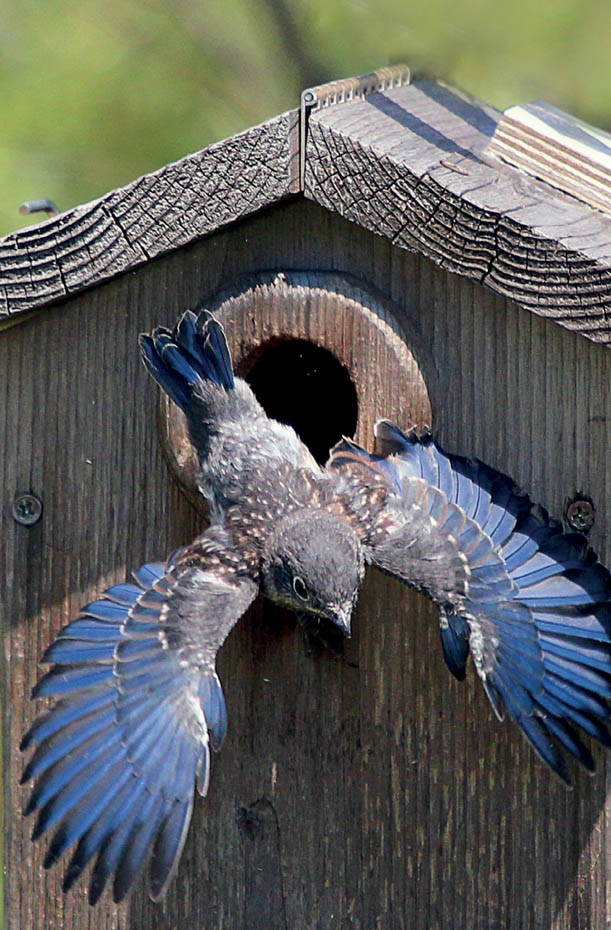
An Eastern Bluebird fledgling takes its first flight from the nest box where it was raised. Bright blue wings and tail identify this one as a male.

A female Eastern Bluebird perches amid winterberry fruits in late autumn. Bluebird young from late-season nests frequently overwinter with their parents.
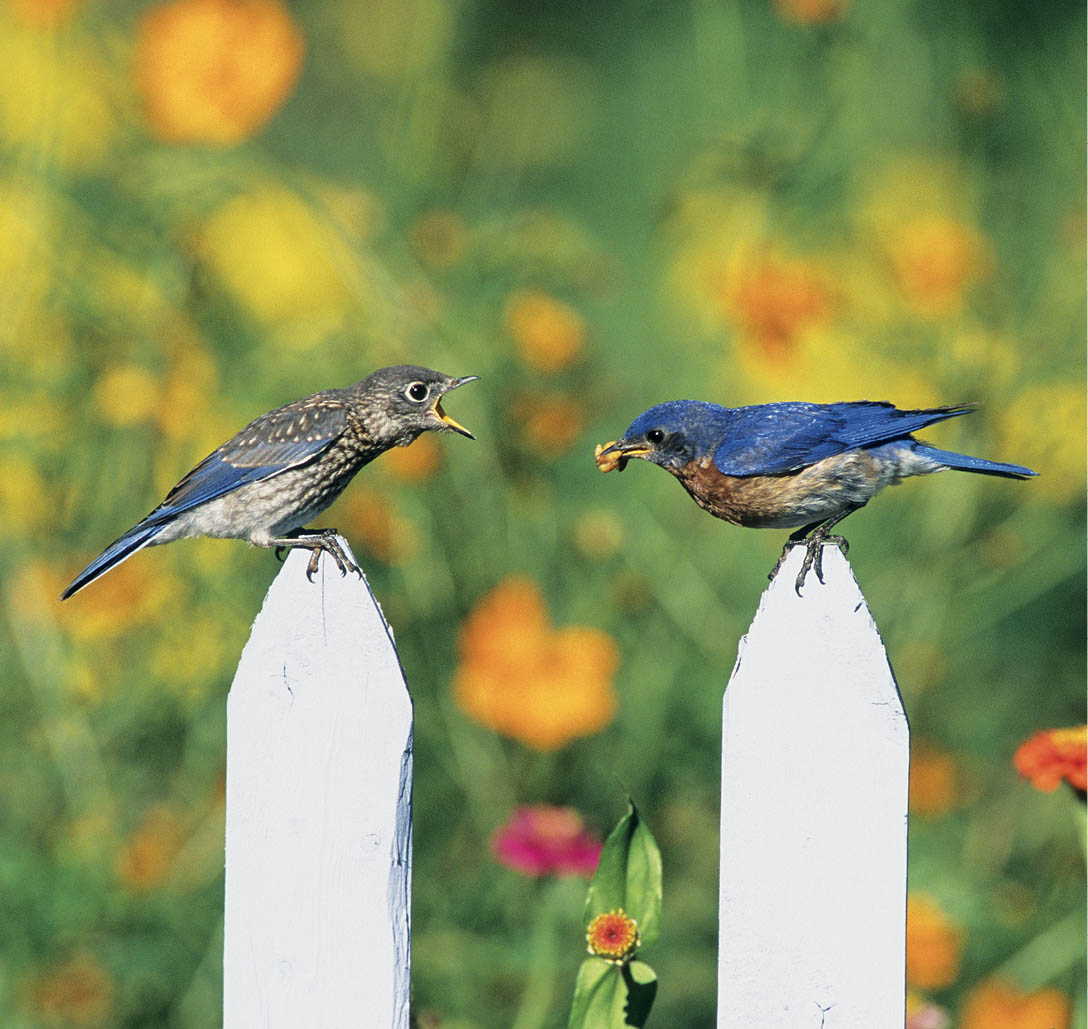
An Eastern Bluebird fledgling begs from its father. Young bluebirds may be fed by their parents for up to three weeks after leaving the nest.
The quintessential backyard bird, the American Robin is by far the continent’s most common thrush and among its most abundant songbirds. Robins breed over virtually all of Canada and the continental United States except the desert Southwest and the southernmost parts of some Gulf States — and those areas are where many may spend the winter.
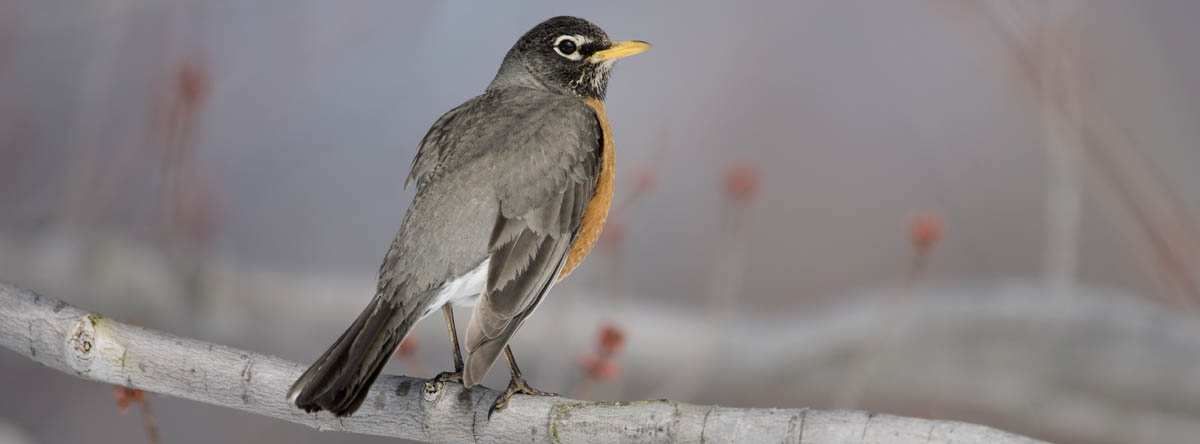
In spring and summer, when males sing their lilting song, robins are most conspicuous; they’re much quieter in fall and winter, even as they move about in huge, sociable flocks. A single feeding group of robins, numbering in the dozens, hundreds, or even thousands, may descend upon a neighborhood nearly unnoticed to devour mountain ash berries, crabapples, or other fruits.
Many fruit trees produce abundantly one year and not at all the next, but robins are naturally nomadic and capitalize on this. Flocks move about restlessly, seeking new food sources, where they settle in only until the food supply starts dwindling. There are occasional squabbles in winter flocks, but overall the birds dine and chatter convivially.
We rarely notice robins until suddenly, just as snows are melting in spring, there they are, running around on patches of exposed lawn. They may have been there all along, but the change in weather stimulates territoriality and a switch in diet. Their seemingly sudden “arrival” corresponds to when the average day/night temperature reaches 37°F (3°C).
Increasing day length and rising temperatures break up the winter flocks. Two males feeling the first surges of territoriality may start singing and fighting, and even before other males grow territorial, their heart rate and blood pressure rise as they hear other males singing. Soon they’re all growing restless and moving northward, while the females remain in flocks a week or two longer. In winter, robins may have squabbled a bit over a berry, but they grow far more belligerent when worms suddenly become available. Even birds still in flocks will make sharp calls and leap into the air to defend their worms.
No bird has adapted as well to the typical backyard habitat as the robin, a bird which scientists believe is far more abundant today than in the ages before European settlers arrived in America. Colonists brought many of their favorite trees and garden plants from Europe, inadvertently importing new species of earthworms to areas that had been devoid of worms since the Ice Age and inviting robins into areas where they’d not formerly been found.
When lawns came into fashion in the late 1800s, robins had even more opportunities to search out the abundant new food source, and the sudden proliferation of ornamental fruit trees augmented their winter diets as well. Mud for nest construction became easy to find along the edges of paths and roadways and in gardens. And window ledges and other structures on houses opened up a whole new niche for nesting.
Robins inspired the saying “The early bird catches the worm,” having a different daily schedule than most birds due to their specialized diet. Earthworms are closest to the ground’s surface at night and early morning, before the sun drives them underground for the day. Robins find worms visually, so males start singing well before dawn, while it’s still quite dark out. This “dawn song” is more rapid and energetic than the song they’ll sing throughout the rest of the day. The dawn singing bout ends when the light level is just high enough for spotting worms. After breakfast, males return to their singing perches to sing on and off throughout the day, with another intense singing bout after sunset.
A territorial robin’s persistent singing is usually enough to keep other males at a distance, but if one does appear, they fight. Occasionally two robins feel an equal claim to a territory and squabbles may last for hours or days, but usually a single battle is enough to determine which bird is most forceful and the other moves on. Robins are so abundant and winter over such a wide range that each male must maintain this high-intensity territoriality for many weeks to fend off new males passing through.
The same assertive singing that repels other males from a robin’s territory lures arriving females. Females are much quieter, but equally territorial toward their own sex. Males don’t get to choose their mate but readily accept whichever female first appears on their territory. It’s up to her to chase off any females who arrive later.
Territories range in size from less than an acre to many times that. The size of a defended territory depends on how much food, water, and nesting materials, especially mud, are available, and how many robins are competing for it.
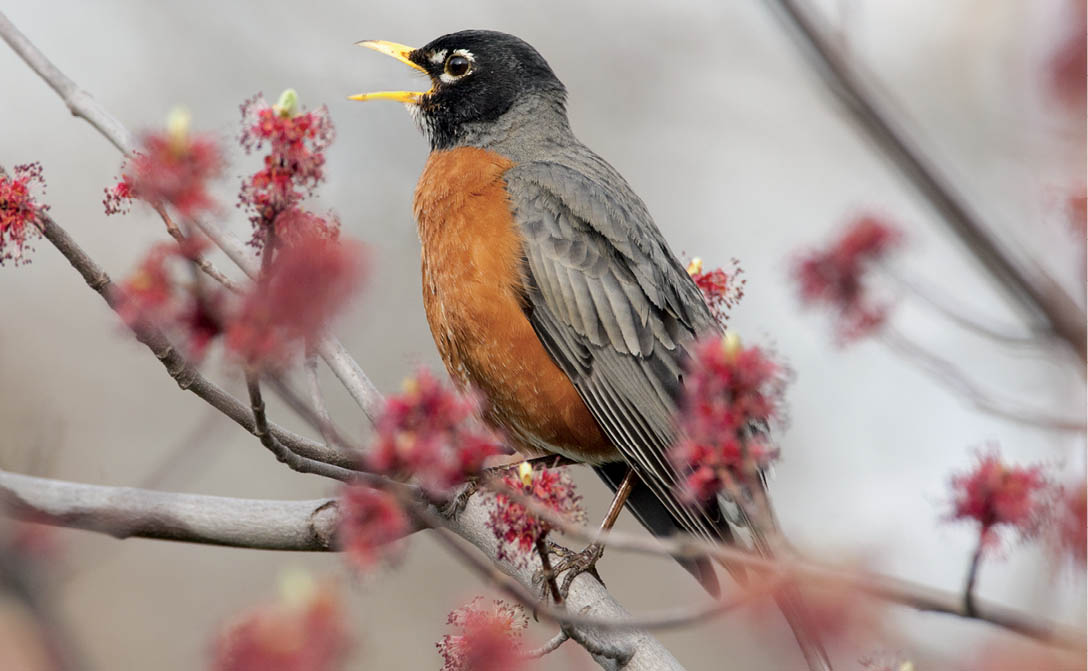
A welcome sign of spring, the American Robin’s song is a string of clear, whistled phrases — cheerily, cheery-up, cheery-up, cheerily — rising and falling in pitch but steady in rhythm, pausing and repeating. The robin is one of the first birds to sing each day, often starting before dawn, and it’s among the last to quiet down in the evening. At dawn, the song is more excited and pours forth without pauses.

An American Robin attacks its reflection in a window, mistaking it for an intruder in its territory. Most territorial encounters between rival birds end quickly, unless the intruder stands its ground. From this bird’s viewpoint, the reflection on a human-made surface is an intruder that won’t go away!
When a female arrives on the territory, the male spends most of his non-singing time following her about, sometimes bringing her nesting materials as she selects the site and constructs the nest. It usually takes five to seven days to build, but if weather is unfavorable or she gets fixated on a window reflection, it can take two weeks or longer. The pair copulates frequently throughout the day during this time.
The female usually builds the first nest of the year in a protective evergreen tree; later nests are built higher in deciduous trees or, on prairies, on the ground. For the bird’s size, the nest is bulky and heavy, and so is built on a fairly sturdy substrate. About a third of the nest’s dry weight may be mud; the rest is grasses, twigs, and other fibers.
The date of laying the first egg, about three or four days after the nest is completed, depends on many variables, including general weather patterns, temperature, day length, and availability of nesting material and food. Robins lay their eggs later in the day than most birds, often at mid-morning or even early afternoon. This is probably due to their diet of worms; they can’t afford to waste the best time for worm hunting in early morning. One egg is laid each day, with a rare gap of a day.
Some females begin incubating after laying the second egg, but many don’t start incubating or attending the nest until they have a full clutch. This leads some people watching robins nesting at their window to fear a nest with eggs has been abandoned. But once the clutch is complete, the female will spend 60 to 80 percent of her day incubating. She leaves the nest for feeding bouts on and off throughout the day, starting about 25 minutes before sunrise when worms are most conspicuous. Males seldom bring food to incubating mates.
Robins of both sexes ward off every competitor that they detect on their property — sometimes even their own reflection. Because they nest so close to and even on our houses, a robin may suddenly spot his or her image in a window or car mirror. He or she will instantly raise the head feathers and assume an aggressive posture, but the reflected robin will match the pose. A male may fly to his favorite perch and start singing. The reflection won’t sing back, confirming the robin’s firm ownership of the territory, but when he returns to the window, there’s the imposter, still aggressive. The next step, whether the robin is a male or female, is to try to chase the invader away.
A few birds do understand reflections. Laboratory studies have shown, for example, that magpies marked with a small spot on their upper breast that they can’t view directly will try to preen it off if they see their image in a mirror. But robins simply don’t understand the concept. When males or females try to chase their image away, the reflections don’t turn tail but, rather, match them blow for blow. Some robins eventually give up and either abandon their own territory or avoid the window area, but a few grow fixated. These constant battles are annoying and frustrating for people living behind the windows, but are even more of a problem for the poor robins, who are losing valuable time needed for proper nesting behaviors, as well as risking injury.
The most merciful thing we can do is break the reflection by covering the outside of the window for a few days. Fortunately, although the problem is not unusual, it’s not too common. Most robins, even those nesting right on window ledges, pay no attention to their reflections and can focus on the business at hand.
The eggs hatch in the order in which they were laid over about two or three days. Each parent feeds the nestlings about six or seven times per hour. Each nestling receives about 3.5 ounces of food, in about 35 to 40 meals, every day. One nestling is fed at each feeding bout. Each parent usually arrives at a predictable location on the nest rim, so nestlings closest to that spot may get fed more often than the others. The parents tend to feed the most conspicuous mouths first, so the nestling that reaches up highest and closest to the feeding parent’s bill is most likely to be fed on that trip.
Once a nestling is comfortably full, it no longer begs as assertively, and the hungrier a nestling is, the more assertively it begs. The first to hatch has a slight size advantage, and nestlings that are more assertive and get the best positions near where the parents arrive will grow faster, but when food is adequate, all the young are likely to fledge. Interestingly, one researcher found that whichever parent provides the most feedings, the father or mother, tends to feed the largest chick most often, and the parent that feeds less often tends to focus more feedings on the smallest.

An American Robin, whose dark head suggests he’s a male, holds a beakful of leaves and mud as nesting material. The male may investigate the nest site before building begins and may bring nesting material to his mate, but the female selects the site and builds the nest.
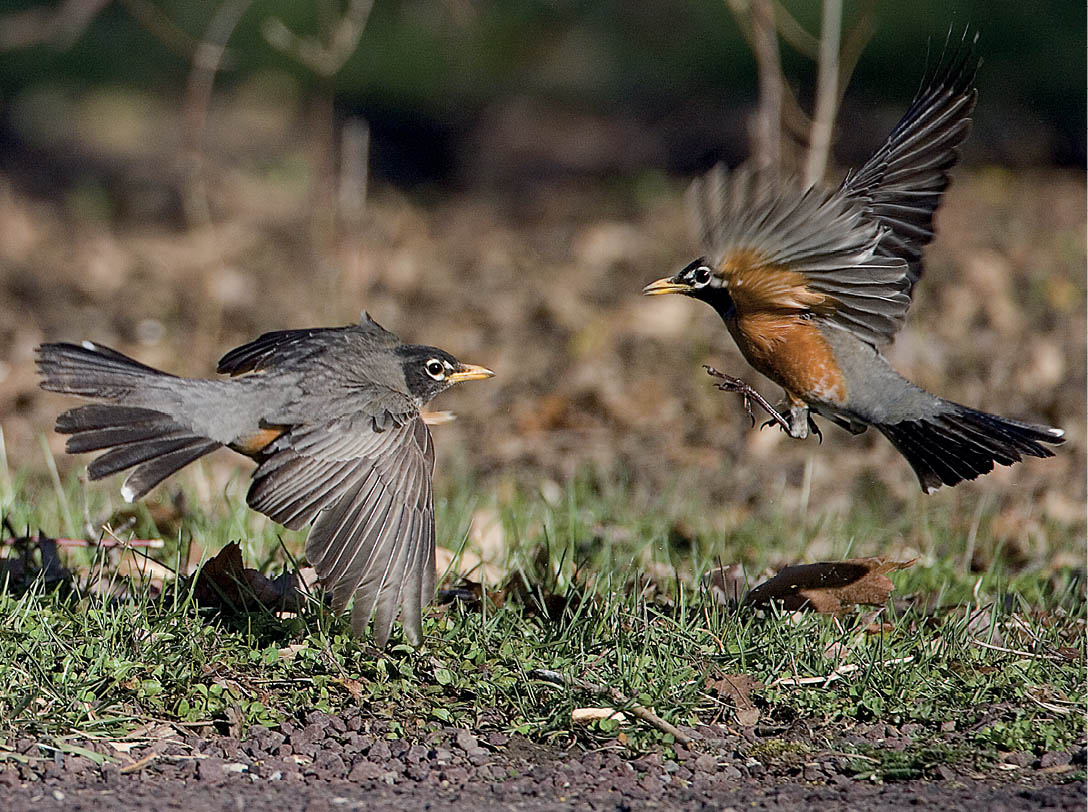
A female American Robin incubates for 12 to 14 days, taking short breaks every 40 minutes or so throughout the day to fly off and feed. Robin nests are found from low branches in shrubs to high treetops, as well as on stumps, among roots in road banks, on rocky ledges, and on human-made structures such as roof gutters, outdoor light fixtures, or under the eaves of buildings.
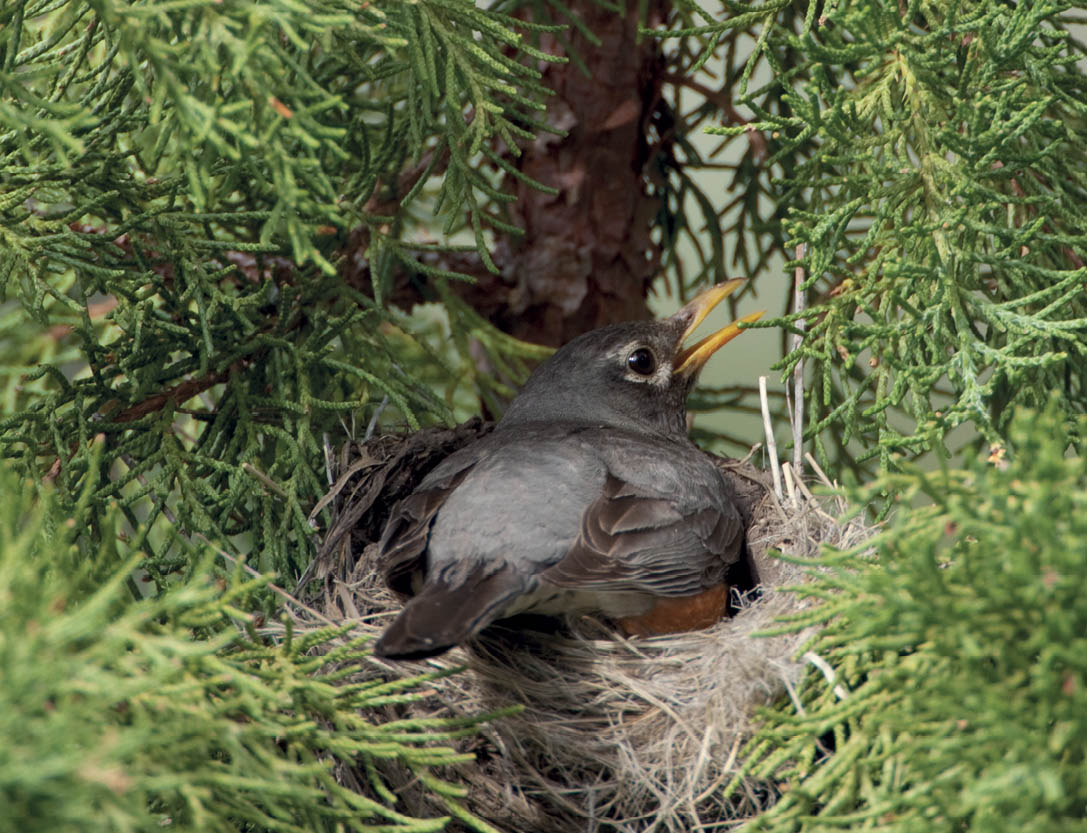
Two robins get into a territorial scuffle in early spring. Competing males intimidate each other by running toward one another in a crouched posture. If neither backs down, altercations may escalate into brief fights, the birds grappling with each on the ground or in midair.
For the first four days or so, the parents regurgitate grubs, worms, and fruits into the nestlings’ mouths. As the chicks grow, the parents start bringing whole insects to thrust into the nestlings’ wide-open gapes. As summer progresses and more fruits become available, they’re offered in addition to insects and worms. Older nestlings can spit out cherry pits and other indigestible materials.
Nestlings produce a fecal sac quickly after eating, while the parent is still present to carry it off. A lot of undigested food remains in the droppings of very young nestlings; the adults eat these fecal sacs. But once bacteria levels in the nestlings’ guts start digesting the food more completely, the adults carry off the sacs to drop away from the nest.
For the first few days after hatching, the female broods the tiny nestlings much of the day, especially when temperatures are low, while the male does most of the feeding. By the time the nestlings are about a week old and can maintain their own body temperatures and keep one another warm, the female no longer broods even at night, retreating to a nearby branch to roost.
4 days old. These four-day-old robin nestlings beg with bright yellow gapes. Altricial, they hatched with sparse white down and eyes closed, but now their down is gray and their eyes partly open. Both parents feed them soft invertebrates such as beetle grubs, caterpillars, and earthworm sections, supplemented with fruit when available.
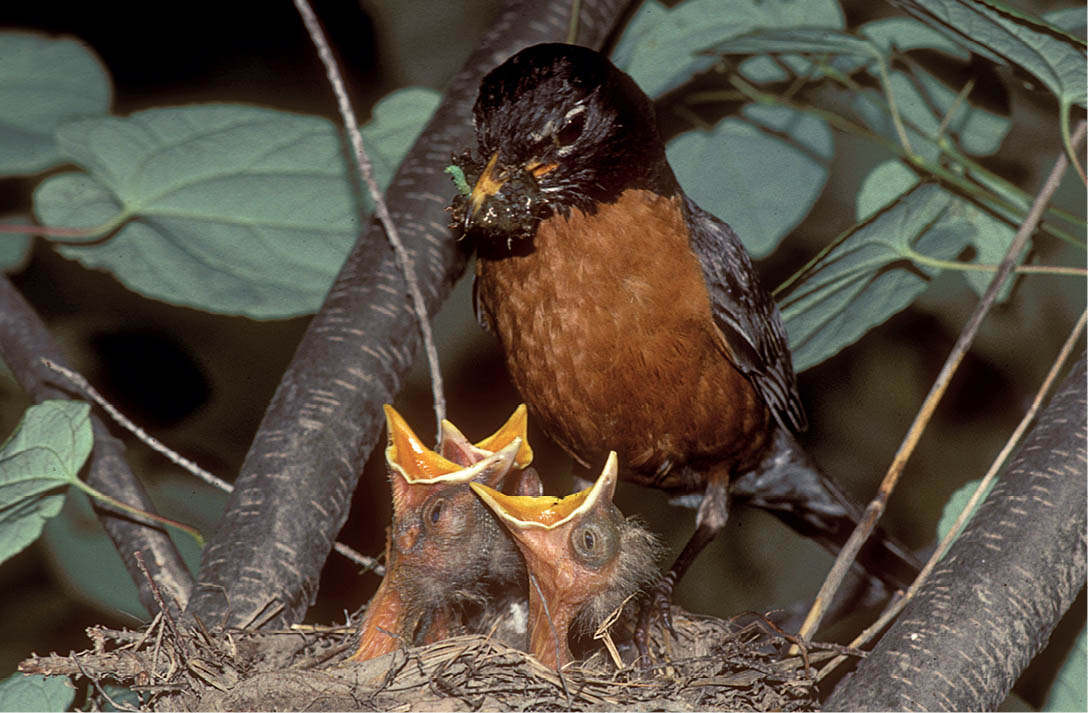
10 days old. A male American Robin brings a large beakful of prey for its nestlings. They now have feathered crowns with only a few wisps of down remaining. Tracts of developing feathers are visible on their backs and wings.
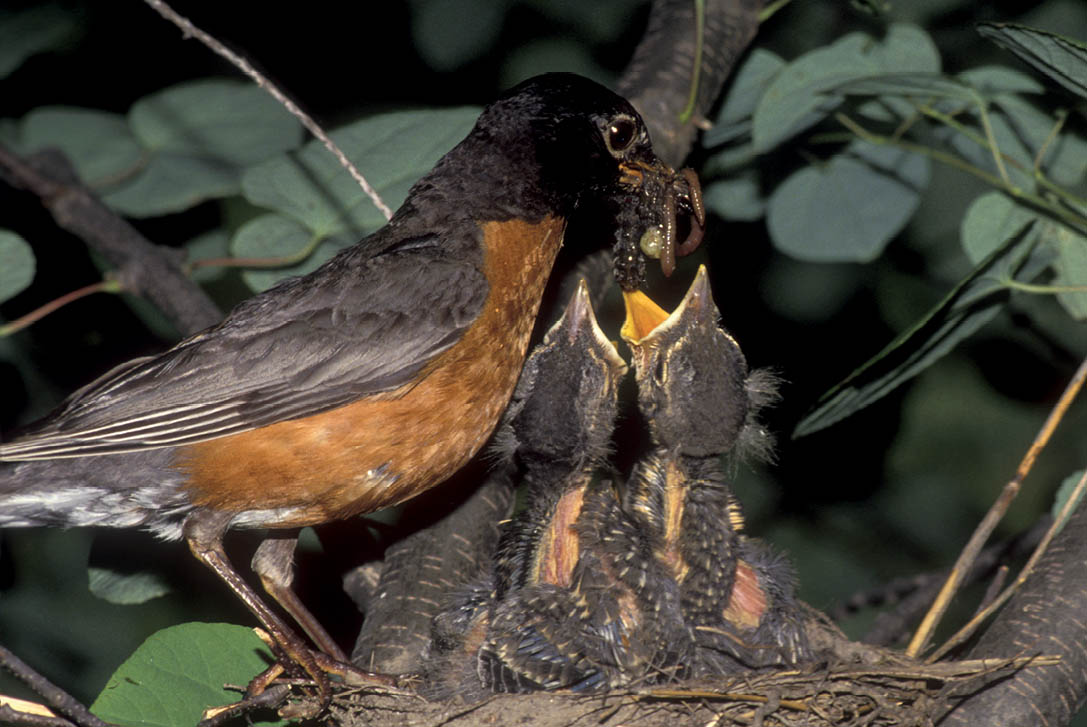
14 days old. A male brings honeysuckle berries for two nestlings that beg and flap their wings vigorously. By now, the young are well feathered, their spotted bellies and flanks showing the rufous colors of adults. Their wing feathers are still partially encased in sheaths, and their tail feathers have hardly emerged at all. Nevertheless, they will fledge shortly (usually before 16 days old).

Robin nestlings grow quickly, reaching their maximum weight when nine or ten days old. After that, as their feathers grow, their bodies lose weight for a few days before they fledge. When undisturbed, they fledge about 12 to 14 days after hatching, but they grow fearful of intruders several days before that. If frightened out of the nest prematurely, their parents may find and continue to feed them, but their chances of survival are greatly reduced.
Usually the entire brood fledges within a day or two. The male focuses mostly on fledged young while the female keeps feeding the chicks still in the nest. When all have fledged, both parents follow and feed them for several days. The female repairs her nest or builds a new one and lays a new clutch, but continues feeding the fledglings on and off until she starts incubating the new eggs. The male remains with them until the new eggs hatch, sometimes roosting near the first brood for several days more.
Baby robins get far more than just food from their parents, especially after they fledge. They follow their parents, learning where and how to obtain food, the best places for roosting, what to do when danger appears, and how to socialize with other robins. After they are on their own, they join with other young robins and unmated adults in loose flocks.
When the first nesting is successful, a pair of robins usually produces a second brood, and sometimes a third. They re-nest if they lose a clutch of eggs or nestlings. By late summer, as adults finish raising their last broods of the year, territoriality has ebbed and they gravitate to a fall feeding flock. They’ll wander about with other robins into the winter until those “first robins of spring” start the cycle all over again.

Now with fully grown wing and tail feathers, this juvenile robin resembles an adult but still has pale spots on its back and wings and dark spots on its breast. It often calls to its parents but no longer depends on them for food. In early autumn, it will join other robins, eventually migrating with them to wintering areas.